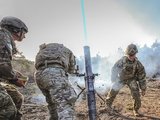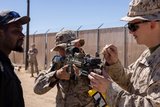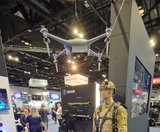Indra begins delivery of fighting vehicle sim to Spanish Army
According to Indra, when all Pizarro simulators are connected, they will constitute one of the largest and most advanced joint armoured vehicle tactical training networks in Europe (Photo: Wikimedia Commons)
Indra has begun delivery of the new simulators for the Pizarro infantry combat vehicle (ICV/C) to Spanish Army bases where this platform is currently deployed, in order to complete the training of its operators.
The delivery includes the first section simulator made up of four vehicle simulators to the base in Córdoba, and over the next month, it will deliver those assigned to bases in Zaragoza and Gerona, followed by those in Badajoz, Madrid, Ceuta and Melilla.
Indra said that when all the simulators are connected, they will constitute one of the largest and most advanced joint armoured vehicle tactical training networks in Europe and one of the most advanced simulation centres in the world.
There will be a total of 56 compartments connected to a simulation network that is currently being planned, in which tactical and collaborative exercises will be conducted with very high realism.
Each of the four vehicle simulators has two compartments: one simulates the driving position, which sits on a three-degree-of-freedom motion platform to simulate terrain inclines and obstacles; and a turret compartment, where the commander and gunner are positioned.
The system simulates the two existing configurations of the Pizarro (Phase I and Phase II) and can be networked with other devices situated in different geographical locations, which allows joint exercises to be carried out, including with other simulation systems available on the Army’s training platform.
'The Pizarro vehicle simulator is designed to develop capabilities and skills in tactical and collaborative training; it allows the soldiers to quickly prepare for their missions, moving around in complex scenarios in which they have to coordinate with their team inside the vehicle and other vehicles in their platoon, and learn how to communicate and coordinate, where to move and how to react in the face of the enemy,’ Rafael Junco, Indra’s simulation director said.
‘It also capitalises on the new technologies linked to virtual reality and gamification and maximises the communication and interoperability capabilities of the systems,' he explained.
Related Equipment in Defence Insight
More from Training
-
![Cubic tailors mortar simulator for the US Army]()
Cubic tailors mortar simulator for the US Army
The company’s mortar trainer received improvements based on soldier’s feedback.
-
![Saab expands footprint in the US]()
Saab expands footprint in the US
The company will operate in two new locations in the coming years to better support US services.
-
![How terrain management capabilities can improve military training]()
How terrain management capabilities can improve military training
This type of tool provides more realistic training easing the incorporation of new scenarios that accurately represent the threats of the battlefield.
-
![I/ITSEC 2024: Australian Army approaches second phase of countermining training]()
I/ITSEC 2024: Australian Army approaches second phase of countermining training
The Engineering Corps has been conducting individual instruction using FLAIM Systems’ Sweeper and should start collective deployments in 2025.
-
![I/ITSEC 2024: Zeiss introduces Velvet 4K SIM projector for night flight simulation]()
I/ITSEC 2024: Zeiss introduces Velvet 4K SIM projector for night flight simulation
The next-generation platform is motion-compatible and can be used in OTW and NVG applications.
-
![I/ITSEC 2024: Saab introduces UAV live training capability]()
I/ITSEC 2024: Saab introduces UAV live training capability
The system can be used to prepare soldiers for both drone offensive operations and CUAS missions.



























